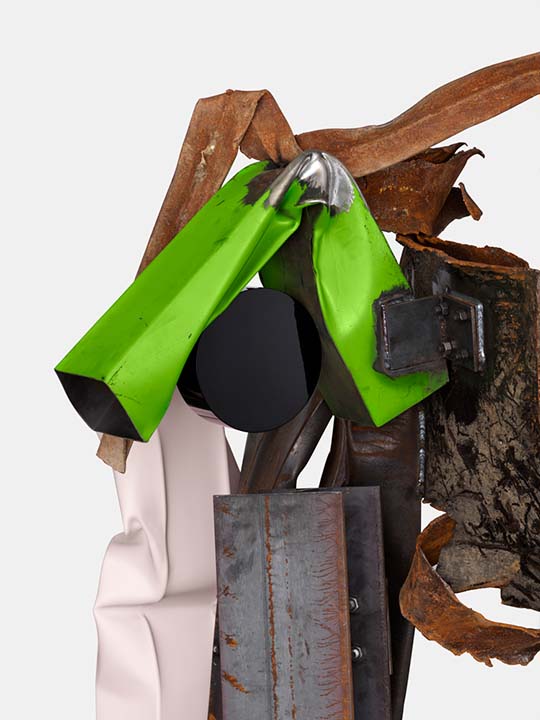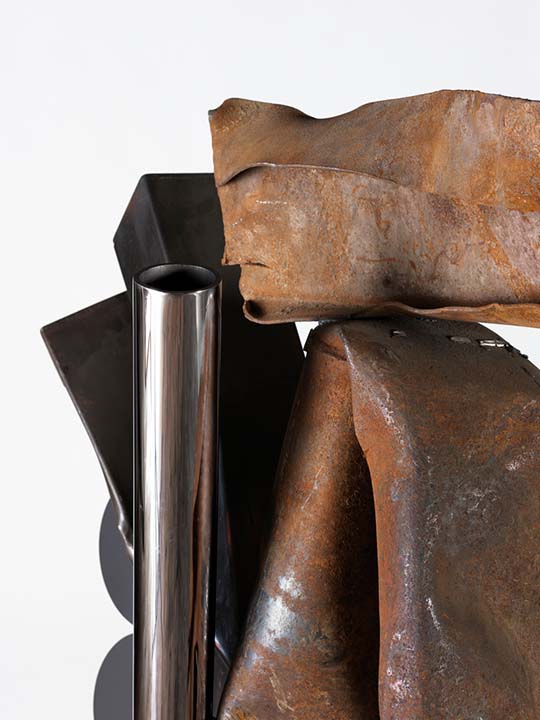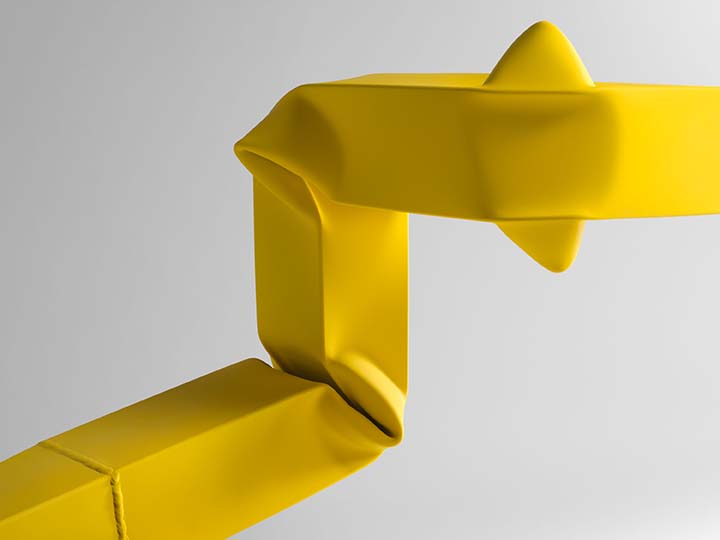In September 2015, Carol Bove visited the Nasher Sculpture Center in Dallas; two months later, I reciprocated at her studio in Red Hook, Brooklyn, to discuss the possibility of an exhibition at the Nasher. Bove had first become known about a decade earlier for precise aggregation of materials—books carefully arrayed on modernist shelves and tables, seashells precariously alight on wire armatures, and other intimately scaled objects—that engaged with the period just before her birth in 1971: the 1960s, with its utopian promises and failures, abundant creativity, and violent upheavals. At the time of our mutual visits, her sculptures and installations had moved away from these types of assemblages; extending into new kinds of spaces, including the outdoors, they featured such elements as petrified wood, I-beams, and a looping white form Bove called a glyph, which succinctly and uncannily encapsulated the signature gesture of a certain type of public art.

Carol Bove, Hylomorph I (detail), 2016. Steel, stainless steel, and urethane paint, 71 1/2 x 42 x 51 in. (181.6 x 106.7 x 129.5 cm). Private collection. © Carol Bove. Courtesy the artist and David Zwirner
Walking through the Nasher and its garden with Bove that day in September, I didn’t know that she was already at the edge of opening her work to more changes. But in Red Hook, I saw works in progress of a very different sort. They were welded and bolted combinations of large flourishes of scrap metal, square tubes bent and crushed into angles, bends, and curves (some of which were painted in confoundingly matte registers of red and other hues), and shiny lacquered cylinders made from the cut-off ends of the white glyphs. We talked that day about a certain mode of sculpture, made in the middle decades of the 20th-century: dynamic, vigorous, often colorful, and produced in spontaneous forays, using means and materials associated with industrial production yet often described in the language of individual subjectivity—a type of sculpture overtaken in the 1960s by the conceptual rigor of Minimalism even as it persisted in plazas and other public spaces. The materials, processes, and syntax of Bove’s nascent sculptures seemed profoundly familiar to me, but there were, thrillingly, elements of the unknown, as if this long-familiar approach to sculpture could lead into places not yet imagined.

Carol Bove, Luxembourg (detail), 2016. Steel, stainless steel, and urethane paint, 72 x 48 x 47 in. (182.9 x 121.9 x 119.4 cm). Private Collection. © Carol Bove. Courtesy the artist and David Zwirner
Her subsequent work has borne that out: Bove has created a stunning range of sculptures in these past few years, from small tabletop knots of steel cloaked in mind-bending hues to the massive yet somehow intimate sculptures of her recent Chimes at Midnight series. While some suggest figures by way of sculptures of the past, such as the winged Nike of Samothrace or Rodin’s The Thinker, most remain abstract, although they often carry allusive and evocative titles. All involve exploring the physical properties of steel through manipulations with an array of tools—many custom-made for this very purpose—that apply pressure to dent, crease, buckle, and crush the metal into such malleability that the results can resemble billowing folds of drapery. The resulting process has become, as Bove has put it, “a story of movement and pressure, force and softness.”

Carol Bove, Mazagan (detail), 2019. Stainless steel and urethane paint 36 1⁄2 x 73 x 27 3/8 in. (92.7 x 185.4 x 69.5 cm). The Green Family Art Foundation and Adam Green Art Advisory. © Carol Bove. Courtesy the artist and David Zwirner
The Nasher’s Carol Bove: Collage Sculptures will be the first major museum presentation focused solely on Bove’s sculptures assembled from scrap and painted steel. Encompassing a range of works in different sizes and formats, all made over the last five years, the exhibition will explore Bove’s work in relation to traditions of the 20th-century sculpture, using the context of the Nasher collection to consider questions of scale, the artist’s investigations of spontaneity and discontinuity in relation to her materials, and the ways that changing contexts of display can shift our understandings of individual artworks or constellations of objects.
Dr. Catherine Craft is a curator at the Nasher Sculpture Center.
Carol Bove: Collage Sculptures will be on view at the Nasher Sculpture Center October 16, 2021–January 9, 2022.